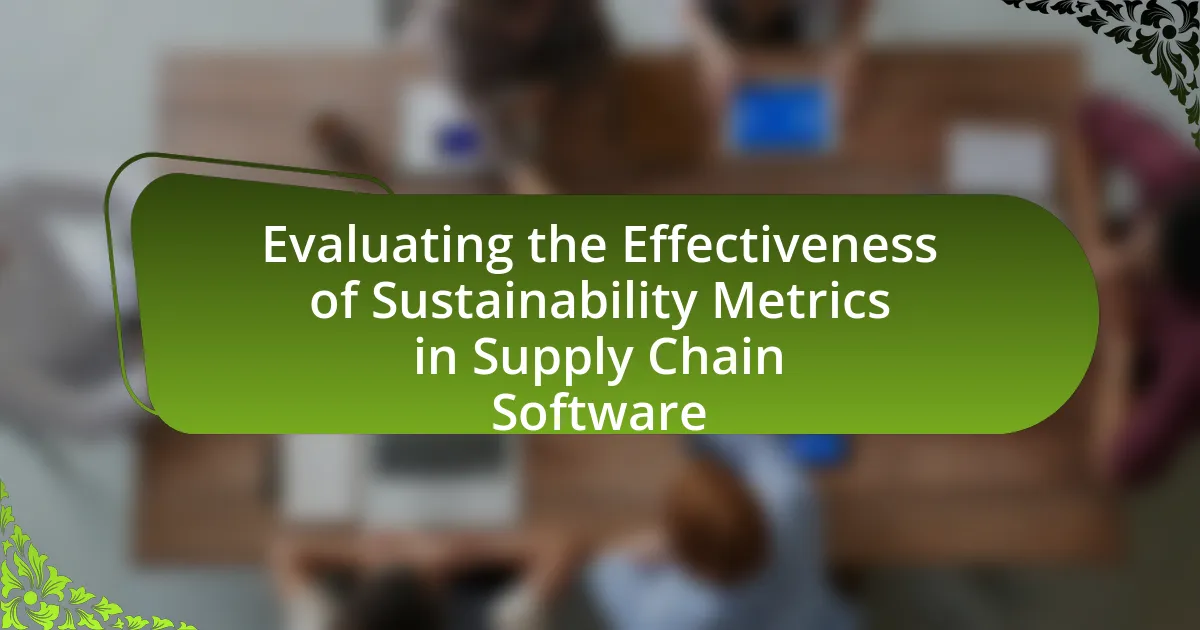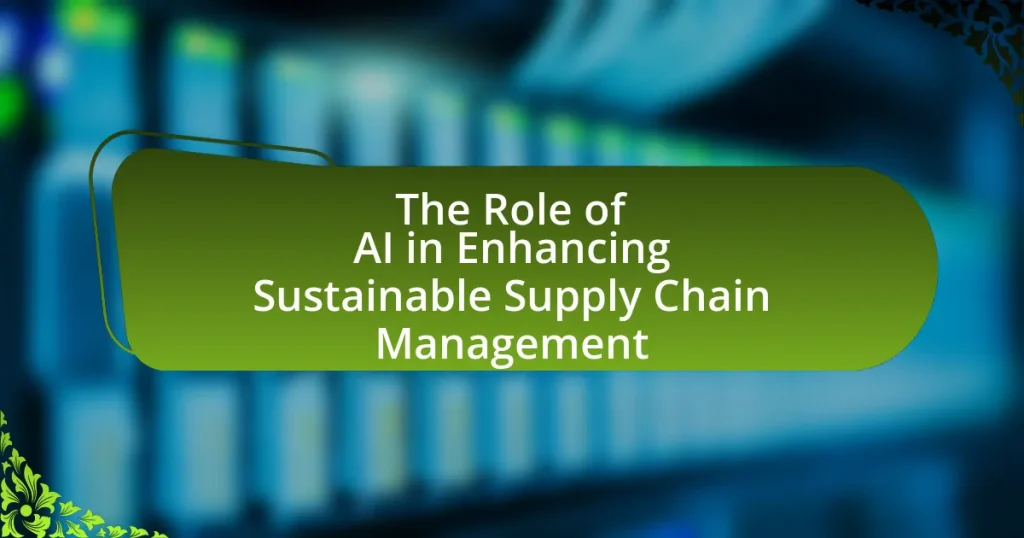The article focuses on evaluating the effectiveness of sustainability metrics in supply chain software, highlighting their role in assessing environmental, social, and economic impacts. It discusses various types of sustainability metrics, such as carbon footprint and resource consumption, and their contribution to improved supply chain management and operational efficiency. The article also addresses the challenges in measuring these metrics, the importance of stakeholder feedback, and best practices for implementation. Additionally, it emphasizes the long-term benefits of effective sustainability metrics, including enhanced decision-making and compliance with regulations, while outlining common pitfalls and practical steps for organizations to improve their evaluation practices.

What are Sustainability Metrics in Supply Chain Software?
Sustainability metrics in supply chain software are quantifiable measures used to assess the environmental, social, and economic impacts of supply chain activities. These metrics enable organizations to evaluate their sustainability performance by tracking factors such as carbon emissions, resource consumption, waste generation, and social responsibility initiatives. For instance, a study by the World Economic Forum highlights that companies utilizing sustainability metrics can reduce their carbon footprint by up to 30% through improved supply chain practices. This demonstrates the effectiveness of sustainability metrics in driving meaningful change within supply chains.
How do sustainability metrics contribute to supply chain management?
Sustainability metrics enhance supply chain management by providing quantifiable data that informs decision-making and improves operational efficiency. These metrics enable organizations to assess environmental impacts, such as carbon emissions and resource usage, which are critical for identifying areas for improvement. For instance, a study by the World Economic Forum indicates that companies implementing sustainability metrics can reduce supply chain costs by up to 20% through optimized resource allocation and waste reduction. By integrating these metrics into supply chain software, businesses can track performance in real-time, ensuring compliance with sustainability goals and fostering transparency throughout the supply chain.
What types of sustainability metrics are commonly used?
Commonly used sustainability metrics include carbon footprint, water usage, waste generation, and energy consumption. These metrics help organizations assess their environmental impact and track progress toward sustainability goals. For instance, the carbon footprint quantifies greenhouse gas emissions, while water usage metrics measure the volume of water consumed in operations. Waste generation metrics evaluate the amount of waste produced, and energy consumption metrics track the total energy used, often expressed in kilowatt-hours. These metrics are essential for organizations aiming to improve their sustainability performance and comply with regulatory standards.
How are these metrics measured and reported?
Metrics in sustainability within supply chain software are measured through quantitative data collection methods, such as surveys, performance tracking, and data analytics. These metrics are reported using dashboards, performance reports, and compliance documentation, which provide stakeholders with insights into sustainability performance. For instance, companies often utilize key performance indicators (KPIs) like carbon footprint reduction, waste management efficiency, and resource utilization rates to gauge effectiveness. Reporting typically follows established frameworks such as the Global Reporting Initiative (GRI) or the Sustainability Accounting Standards Board (SASB), ensuring standardized and transparent communication of sustainability efforts.
Why is it important to evaluate the effectiveness of sustainability metrics?
Evaluating the effectiveness of sustainability metrics is crucial because it ensures that organizations accurately measure their environmental impact and progress toward sustainability goals. Effective metrics provide reliable data that can inform decision-making, optimize resource use, and enhance accountability. For instance, a study by the Global Reporting Initiative found that companies using robust sustainability metrics are 30% more likely to achieve their sustainability targets compared to those that do not. This demonstrates that proper evaluation of these metrics leads to improved performance and transparency in sustainability efforts.
What challenges exist in measuring sustainability metrics?
Measuring sustainability metrics faces several challenges, including data availability, standardization, and complexity of metrics. Data availability is often limited due to inconsistent reporting practices across organizations, making it difficult to obtain comprehensive and comparable information. Standardization poses a challenge as various frameworks and methodologies exist, leading to discrepancies in how metrics are defined and calculated. Additionally, the complexity of sustainability metrics, which often encompass environmental, social, and economic dimensions, complicates the measurement process, as organizations may struggle to integrate diverse data sources and assess their interdependencies. These challenges hinder the accurate evaluation of sustainability performance in supply chain software.
How do ineffective metrics impact supply chain decisions?
Ineffective metrics significantly hinder supply chain decisions by providing misleading information that can lead to poor strategic choices. When metrics fail to accurately reflect performance, organizations may misallocate resources, resulting in increased costs and inefficiencies. For instance, a study by the Supply Chain Management Review found that companies relying on outdated or irrelevant metrics experienced a 20% increase in operational costs due to misinformed inventory management decisions. Consequently, ineffective metrics can distort visibility into supply chain performance, ultimately undermining the ability to achieve sustainability goals and optimize overall efficiency.

How can the effectiveness of sustainability metrics be evaluated?
The effectiveness of sustainability metrics can be evaluated through quantitative analysis, benchmarking, and stakeholder feedback. Quantitative analysis involves measuring specific performance indicators, such as carbon emissions reduction or resource efficiency, against predefined targets. Benchmarking compares these metrics with industry standards or best practices to assess relative performance. Stakeholder feedback, including insights from employees, customers, and suppliers, provides qualitative data that can highlight areas for improvement and validate the relevance of the metrics used. Together, these methods ensure a comprehensive evaluation of sustainability metrics in supply chain software.
What criteria should be used to assess sustainability metrics?
To assess sustainability metrics, criteria should include relevance, accuracy, completeness, consistency, and timeliness. Relevance ensures that the metrics align with the specific sustainability goals of the organization. Accuracy involves the precision of the data collected, which is critical for reliable decision-making. Completeness refers to the extent to which all necessary data is included to provide a full picture of sustainability performance. Consistency ensures that metrics are applied uniformly over time, allowing for comparability. Timeliness relates to the availability of data when needed for effective management and reporting. These criteria are essential for evaluating the effectiveness of sustainability metrics in supply chain software, as they directly impact the quality and utility of the information provided for decision-making.
How do qualitative and quantitative measures differ in evaluation?
Qualitative and quantitative measures differ in evaluation primarily in their approach to data collection and analysis. Qualitative measures focus on descriptive data, capturing insights through interviews, observations, and open-ended surveys, which provide depth and context to the evaluation. In contrast, quantitative measures rely on numerical data, utilizing structured surveys, statistical analysis, and metrics that allow for objective measurement and comparison. For instance, qualitative evaluations might reveal stakeholder perceptions of sustainability practices, while quantitative evaluations could measure the percentage reduction in carbon emissions. This distinction is crucial in evaluating the effectiveness of sustainability metrics in supply chain software, as both types of measures can provide complementary insights into performance and impact.
What role does stakeholder feedback play in evaluation?
Stakeholder feedback is crucial in evaluation as it provides insights that enhance the accuracy and relevance of assessment processes. This feedback allows evaluators to understand the perspectives and needs of various stakeholders, ensuring that the evaluation aligns with their expectations and objectives. For instance, in the context of sustainability metrics in supply chain software, stakeholder feedback can identify gaps in data collection or highlight areas for improvement, leading to more effective and targeted sustainability initiatives. Research indicates that incorporating stakeholder input can increase the credibility and acceptance of evaluation findings, ultimately driving better decision-making and outcomes in sustainability efforts.
What tools and methodologies are available for evaluation?
Various tools and methodologies are available for evaluating sustainability metrics in supply chain software, including Life Cycle Assessment (LCA), Key Performance Indicators (KPIs), and Sustainability Reporting Frameworks. Life Cycle Assessment provides a comprehensive analysis of environmental impacts throughout a product’s life cycle, enabling organizations to identify areas for improvement. Key Performance Indicators offer quantifiable measures to assess sustainability performance, facilitating benchmarking against industry standards. Sustainability Reporting Frameworks, such as the Global Reporting Initiative (GRI) and the Sustainability Accounting Standards Board (SASB), provide structured guidelines for reporting sustainability metrics, ensuring transparency and accountability. These methodologies are widely recognized and utilized in the industry, reinforcing their validity in evaluating sustainability metrics effectively.
How can software solutions enhance the evaluation process?
Software solutions can enhance the evaluation process by providing real-time data analytics and automated reporting capabilities. These features enable organizations to assess sustainability metrics more accurately and efficiently, leading to informed decision-making. For instance, software tools can aggregate data from various supply chain stages, allowing for comprehensive evaluations of sustainability performance. According to a study by the Journal of Cleaner Production, companies that implemented data-driven software solutions reported a 30% improvement in their ability to track and evaluate sustainability metrics. This demonstrates that software solutions not only streamline the evaluation process but also significantly enhance the accuracy and effectiveness of sustainability assessments in supply chains.
What are the best practices for implementing evaluation methodologies?
The best practices for implementing evaluation methodologies include defining clear objectives, selecting appropriate metrics, ensuring stakeholder involvement, and conducting regular reviews. Clear objectives guide the evaluation process, while appropriate metrics provide measurable outcomes that align with sustainability goals. Stakeholder involvement ensures that diverse perspectives are considered, enhancing the relevance and acceptance of the evaluation. Regular reviews allow for adjustments based on feedback and changing conditions, ensuring the methodology remains effective and aligned with the overall sustainability strategy in supply chain software.

What are the implications of effective sustainability metrics in supply chain software?
Effective sustainability metrics in supply chain software lead to improved decision-making, enhanced operational efficiency, and greater compliance with environmental regulations. By accurately measuring sustainability performance, organizations can identify areas for improvement, optimize resource use, and reduce waste. For instance, a study by the World Economic Forum indicates that companies implementing sustainability metrics can achieve up to a 20% reduction in operational costs through better resource management. Additionally, effective metrics facilitate transparency and accountability, which can enhance brand reputation and customer loyalty.
How do effective metrics influence supply chain performance?
Effective metrics significantly enhance supply chain performance by providing measurable insights that drive decision-making and operational efficiency. These metrics enable organizations to track key performance indicators (KPIs) such as inventory turnover, order accuracy, and lead times, which directly correlate with overall supply chain effectiveness. For instance, a study by the Council of Supply Chain Management Professionals found that companies utilizing advanced metrics reported a 15% improvement in operational efficiency. By identifying areas for improvement and facilitating data-driven strategies, effective metrics lead to reduced costs, improved customer satisfaction, and increased agility in responding to market changes.
What are the long-term benefits of using effective sustainability metrics?
Effective sustainability metrics provide long-term benefits such as improved resource efficiency, enhanced brand reputation, and better regulatory compliance. By accurately measuring sustainability performance, organizations can identify areas for resource optimization, leading to cost savings and reduced environmental impact. For instance, companies that implement sustainability metrics often report a 20% reduction in energy consumption over five years, as evidenced by a study from the Carbon Trust. Additionally, strong sustainability practices can enhance brand loyalty, with 66% of consumers willing to pay more for sustainable brands, according to Nielsen. Furthermore, effective metrics help organizations stay ahead of regulatory requirements, minimizing the risk of fines and enhancing operational resilience.
How can organizations leverage effective metrics for competitive advantage?
Organizations can leverage effective metrics for competitive advantage by utilizing data-driven insights to optimize operations and enhance decision-making. By implementing sustainability metrics within supply chain software, organizations can track performance indicators such as carbon emissions, resource usage, and waste reduction. For instance, a study by the World Economic Forum found that companies adopting sustainability metrics can improve operational efficiency by up to 20%, leading to cost savings and improved brand reputation. This strategic use of metrics enables organizations to identify areas for improvement, align with consumer preferences for sustainable practices, and ultimately differentiate themselves in the marketplace.
What are common pitfalls in evaluating sustainability metrics?
Common pitfalls in evaluating sustainability metrics include a lack of standardization, insufficient data quality, and failure to consider the broader context. The absence of universally accepted standards can lead to inconsistent measurements across different organizations, making comparisons difficult. Additionally, poor data quality, such as incomplete or inaccurate information, can skew results and misinform decision-making. Lastly, neglecting to account for external factors, such as regional regulations or market conditions, can result in an incomplete understanding of sustainability performance. These pitfalls can undermine the effectiveness of sustainability metrics in supply chain software, leading to misguided strategies and ineffective resource allocation.
How can organizations avoid these pitfalls?
Organizations can avoid pitfalls in evaluating sustainability metrics in supply chain software by implementing a structured framework for assessment. This framework should include clear criteria for measuring sustainability performance, regular audits of the metrics used, and continuous stakeholder engagement to ensure alignment with sustainability goals. Research indicates that organizations that adopt systematic evaluation processes, such as the use of the Global Reporting Initiative (GRI) standards, achieve better transparency and accountability in their sustainability efforts. Additionally, leveraging technology for real-time data analysis can help organizations identify discrepancies and areas for improvement, thereby enhancing the effectiveness of their sustainability metrics.
What lessons can be learned from unsuccessful evaluations?
Unsuccessful evaluations reveal critical lessons about the importance of clear objectives and stakeholder engagement. Specifically, they highlight that lacking well-defined goals can lead to misaligned metrics, resulting in ineffective assessments. For instance, a study by the Harvard Business Review indicates that 70% of organizations fail to achieve their strategic objectives due to unclear performance metrics. Additionally, unsuccessful evaluations often underscore the necessity of involving relevant stakeholders throughout the evaluation process, as their insights can enhance the relevance and applicability of the metrics used. This involvement can prevent the common pitfall of using metrics that do not resonate with the actual challenges faced in sustainability efforts within supply chains.
What practical steps can organizations take to improve sustainability metric evaluation?
Organizations can improve sustainability metric evaluation by implementing standardized measurement frameworks, such as the Global Reporting Initiative (GRI) or the Sustainability Accounting Standards Board (SASB) guidelines. These frameworks provide clear metrics and benchmarks that facilitate consistent data collection and reporting across various sustainability dimensions. Additionally, organizations should invest in advanced data analytics tools to enhance the accuracy and granularity of sustainability data, enabling better insights into performance trends. For instance, a study by the World Economic Forum highlights that companies utilizing data analytics can achieve up to 20% improvement in sustainability performance metrics. Furthermore, fostering cross-departmental collaboration ensures that sustainability metrics are integrated into all relevant business processes, promoting a holistic approach to sustainability evaluation.
How can continuous improvement be integrated into the evaluation process?
Continuous improvement can be integrated into the evaluation process by establishing a systematic framework that incorporates regular feedback loops and performance metrics. This framework should include setting clear sustainability goals, measuring progress against those goals, and analyzing data to identify areas for enhancement. For instance, organizations can utilize key performance indicators (KPIs) related to sustainability metrics, such as carbon footprint reduction or waste minimization, to assess effectiveness. By regularly reviewing these metrics and soliciting stakeholder feedback, companies can adapt their strategies and processes, ensuring ongoing alignment with sustainability objectives. This approach is supported by research indicating that organizations employing continuous improvement methodologies, such as Plan-Do-Check-Act (PDCA), achieve higher levels of operational efficiency and sustainability outcomes.
What resources are available for organizations seeking to enhance their evaluation practices?
Organizations seeking to enhance their evaluation practices can access various resources, including evaluation frameworks, training programs, and online tools. Evaluation frameworks, such as the Logic Model and Theory of Change, provide structured approaches to assess program effectiveness. Training programs offered by organizations like the American Evaluation Association equip professionals with skills in evaluation design and implementation. Additionally, online tools like SurveyMonkey and Google Forms facilitate data collection and analysis, enabling organizations to gather feedback efficiently. These resources collectively support organizations in improving their evaluation practices and ensuring more effective assessments of sustainability metrics in supply chain software.



